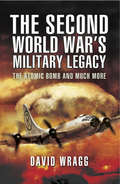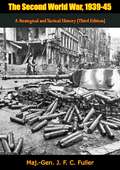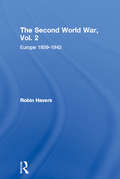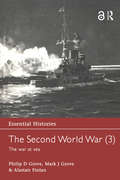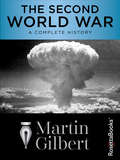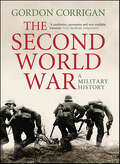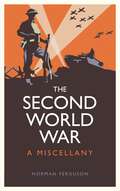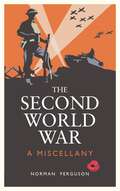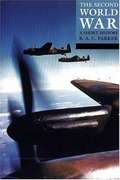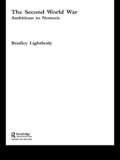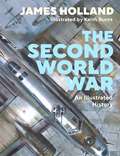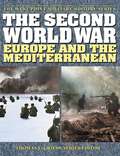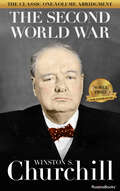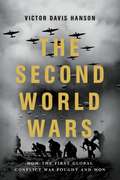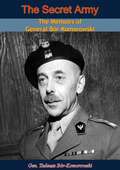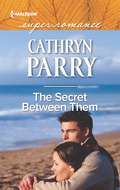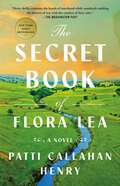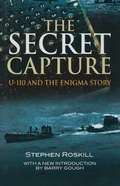- Table View
- List View
The Second World War's Military Legacy: The Atomic Bomb and Much More
by David Wragg'Necessity is the mother of invention' and nothing is more necessary than victory in war. Driven by the need to defeat Hitler's Nazis and Japanese Imperial ambitions, the period 1939 1945 saw huge and unprecedented leaps in the invention and development of war winning weapons and technology.Well=known author and military expert David Wragg has studied the whole range of land, sea and air technical innovations that originated during the Second World War. Most obvious and strategically important is the Atomic Bomb (and its successor the Hydrogen Bomb) but the list is truly fascinating cruise and ballistic missiles, landing craft, self-propelled guns assault ships, IFF (identification friend or foe), jet engines, sonar, ejection seats to name but some.A number of inventions, while important at the time, had no longer term use; for instance dive-bombers. Others were available but not used until post-war such as in-flight refuelling.The author concludes from his extensive research arguing that there is little new in defence today as so many modern weapons trace their origins back to the Second World War.This is an original and thought-provoking book by a highly respected military history author.
The Second World War, 1939-45: A Strategical and Tactical History [Third Edition]
by Maj.-Gen J. F. C. FullerBritish General J. F. C. Fuller is one of the greatest military thinkers of this century, and has been called the Clausewitz of our time. This book is Fuller’s direct and clear-eyed account of the most terrible war of the modern era. When first published in 1948, it received notices such as these:“The strategic and tactical phases of the war are brilliantly expounded...on that score, the book stands as probably the best comprehensive work on the war to appear so far.”—The New Yorker“The narrative, valuable as it is, is not the most important part of General Fuller’s book. What really matters is the author’s comments on the events he describes, and these provide us with a clear statement of what he thinks not only about particular operations but about the conduct of the war as a whole. The result is a hard-hitting politico-military pamphlet, in which none of the punches are pulled.”—The Spectator“[Fuller] knows how to handle a narrative full of incident; he is thoroughly at home in a subject in which he has kept himself up to date; and...he is one of the very rare original students of warfare whom this country has produced.”—Times Literary SupplementFuller’s biographer, Bryan Holden Reid, has described The Second World War as “an analysis of the breakdown, as Fuller saw it, of the vital relationship between grand strategy and grand tactics—the end and the means....Too often books on the Second World War detail the movements of formations about the battlefield and give space to strategical commentary without assessing the manner in which the war was actually fought. On the tactical level, The Second World War can still be read with profit.”Expertly combining detailed military history and analysis with Clausewitzian insights based on his own theories of warfare, Fuller produced a modern military masterpiece in The Second World War.
The Second World War, Vol. 2: Europe 1939-1943 (Essential Histories)
by Robin HaversWhile many of the participants were the same as the First World War, this conflict was far more than a re-match of 1914-1918. The Second World War was even more destructive than the first and the added ideological element meant that this war was far more cruel. This book details the first four years of the war in Europe. It discusses how and why Hitler's resurgent Germany plunged into war, and examines the German successes against Poland, France, and the Low Countries.
The Second World War, Vol. 3: The War at Sea (Essential Histories)
by Alastair Finlan Philip D. Grove Mark J. GroveThis volume provides a comprehensive guide to three major theaters of combat: the Atlantic, the Mediterranean, and the Indian Ocean. The war at sea was a critical contest, as sea-lanes provided the logistical arteries for British and subsequent Allied armies fighting on the three continents of Africa, Asia, and Europe. Land forces ultimately won World War II, but the battles at sea fundamentally altered the balance of military power on the ground.
The Second World War: A Complete History
by Martin Gilbert&“Mr. Gilbert brings the strongest possible credentials to his history of World War II, and the result is a magisterial work&” (The New York Times). In the hands of master historian Martin Gilbert, the complex and compelling story of the Second World War comes to life. This narrative captures the perspectives of leading politicians and war commanders, journalists, civilians, and ordinary soldiers, offering gripping eyewitness accounts of heroism, defeat, suffering, and triumph. This is one of the first historical studies of World War II that describes the Holocaust as an integral part of the war. It also covers maneuvers, strategies, and leaders operating in European, Asian, and Pacific theatres. In addition, this book brings in survivor testimonies of occupation, survival behind enemy lines, and the experience of minority groups such as the Roma in Europe, to offer a comprehensive account of the war&’s impact on individuals on both sides. This is a sweeping narrative of one of the most deadly wars in history, which took almost forty million lives, and irrevocably changed countless more. &“Gilbert&’s flowing narrative is spiced with anecdotal details culled from diaries, memoirs, and official documents. He is especially skillful at interweaving summaries of military strategy with vignettes of civilian suffering.&” —Newsweek &“[A] masterful account of history&’s most destructive conflict.&” —Publishers Weekly
The Second World War: A Military History
by Gordon CorriganA landmark reassessment of World War II that reconsiders the immense six-year conflict under the lens of the many separate campaigns fought in Europe, Asia, and the Mediterranean.A definitive single-volume military history of World War II, Gordon Corrigan's The Second World War reveals the vastly diverse ways in which each campaign was waged against very different enemies who rarely, if ever, coordinated their efforts. Corrigan, who has developed a scholarly reputation of challenging long-held historical assumptions, examines the agendas of the warring nations and offers fresh and vivid interpretations of how the war was fought and how it was won. In particular, the author dispels myths regarding the effectiveness of the American and British war efforts and brings the contributions of the Russian armies to the forefront. Vast in vision and epic in scope, The Second World War will change forever the way we think about the titanic conflicts that decided the shape of the modern world.
The Second World War: A Miscellany
by Norman FergusonFrom the horrors of the Holocaust to the D-Day landings, the Second World War changed the political, social and economic structure of the world. Through its battles, aircraft, weapons, soldiers, campaigns and heroes, this miscellany is a compelling guide to one of the most destructive and all-encompassing wars the world has ever seen.
The Second World War: A Miscellany
by Norman FergusonFrom the horrors of the Holocaust to the D-Day landings, the Second World War changed the political, social and economic structure of the world. Through its battles, aircraft, weapons, soldiers, campaigns and heroes, this miscellany is a compelling guide to one of the most destructive and all-encompassing wars the world has ever seen.
The Second World War: A Miscellany
by Norman FergusonTelling the stories of the Battle of Britain, the Siege of Leningrad, the horrors of the Holocaust, the D-Day landings and the other battles, campaigns, aircraft, weapons, soldiers and heroes on the Home Front and abroad, this is a compelling guide to one of the most destructive and all-encompassing wars the world has ever seen.
The Second World War: A Short History
by R. A. C. ParkerThis is a compact but comprehensive and absorbing history of the Second World War. It examines the causes of the war, how it was won and lost, and its far-reaching consequences for humanity.
The Second World War: Ambitions to Nemesis
by Bradley LightbodyBradley Lightbody presents a fascinating and accessible history of the Second World War in its global context. Examining the war around general themes from ambition and advance, through expansion and containment, to rout and victory, The Second World War covers all the major theatres and events of the war. From the origins and background to the war to its aftermath and legacy, The Second World War covers: * the pre-war ambitions of Italy, Germany and Japan* the outbreak of the war in Poland* the 'Phoney War'* Blitzkrieg, the Fall of France and the Battle of Britain* Pearl Harbour* the war in North Africa and El Alamein* the final solution* D-Day, the liberation of Italy and deliverance from the concentration camps* the bombing of Hiroshima and Nagasaki. This book provides a comprehensive overview of the global ambitions and the global warfare that was the Second World War, making it essential reading for all students of twentieth century world history.
The Second World War: An Illustrated History
by James HollandDiscover the story of the Second World War brought to life in full colour by renowned historian James Holland and award-winning artist Keith Burns'A fully immersive experience. A comprehensive yet fast-paced and gripping insight into the Second World War. Not just accessible, but riveting. An absolute pleasure to read' GET HISTORY'A ground-breaking collaboration between bestselling historian James Holland and award-winning artist Keith Burns presents the war in full colour, bringing the text vividly to life' HISTORY OF WAR__________From the great cities of Europe to the jungles of Burma, and from the deserts of North Africa to the remote islands of the South Pacific and the freezing waters of the Arctic, the Second World War touched every continent and ocean on the planet. And from the Blitzkrieg to the atom bomb, the fighting fuelled new technological development on land, at sea and in the air at a ferocious pace. Our future was forged by war.Combining compelling personal stories with a clear and accessible appreciation of the strategic and operational battle for supremacy between the Allies and the Axis powers, bestselling historian James Holland weaves an irresistible narrative, with over 250 illustrations by acclaimed artist Keith Burns, commissioned specially for this project.Together, they bring events in The Second World War: An Illustrated History to life with stunning drama and dynamism.Over five years in the making, their groundbreaking collaboration has produced a unique and unforgettable account of the most extraordinary events the world has ever seen.__________'Gripping text, masterful imagery and touching personal stories make this a must-buy for anyone with an interest in World War Two' CLASSIC MILITARY VEHICLES'A bold attempt to expand the market for military history . . . aimed at a general reader who wants to get an overall grasp of a massive subject . . . this is an impressive achievement' BOOKBRUNCH
The Second World War: Asia And The Pacific (The West Point Military History Series)
by Thomas E. GriessBeginning with a look at the readiness of the Imperial Japanese Army and Navy and the United States armed forces, this book gives a detailed account of the Allies’ brutal five-year struggle with Japan. It examines the interrelationship of land, sea, and air forces as they battled over the vast reaches of the Pacific Theater of War.
The Second World War: Asia and the Pacific
by John H. Bradley, Jack W. Dice and Thomas E. Griess*** OVER 210,000 WEST POINT MILITARY HISTORY SERIES SETS IN PRINT ***Beginning with a look at the readiness of the Imperial Japanese Army and Navy and the United States armed forces, this book gives a detailed account of the Allies&’ brutal five-year struggle with Japan. It examines the interrelationship of land, sea, and air forces as they battled over the vast reaches of the Pacific Theater of War.
The Second World War: Europe and the Mediterranean
by Thomas E. Griess*** OVER 210,000 WEST POINT MILITARY HISTORY SERIES SETS IN PRINT ***From the prewar development of the German war machine to the ultimate victory of the Allied coalition, here is an in-depth analysis of the battles that raged on the Western and Eastern Fronts. It examines the major strategies, the innovative tactics, and the new generation of weapons—along with the people who used them.
The Second World War: The Classic One-Volume Abridgment (Winston S. Churchill The Second World War)
by Winston S. ChurchillThe former Prime Minister and Nobel Prize–winning author chronicles Britain’s World War II experience from the aftermath of WWI to July 1945.World War II was the most pivotal event of the twentieth century. It was Great Britain’s darkest and finest hour in which the nation’s people showed great resilience and resourcefulness. Helping to lead them through this tumultuous era was Sir Winston Churchill. The Second World War is his account of the period, compiled using his own notes as well as official documents to which he had official access.This edition of The Second World War is the classic one-volume abridgment of Sir Winston Churchill’s landmark history of the conflict. It was abridged by Denis Kelly (with Churchill’s approval) of the following volumes composed by Churchill: The Gathering Storm, The Finest Hour, The Grand Alliance, The Hinge of Fate, Closing the Ring, and Triumph and Tragedy. This edition also features Churchill’s epilogue now published in book form for the first time. At once a personal account and a magisterial history, this remains Churchill's literary masterpiece.
The Second World War: Volume III The Japanese War 1941–1945 (The Second World War)
by Jeremy BlackWorld War II defined the 20th century and shaped the contemporary world; from the decolonization of Africa to the rise and fall of the Berlin Wall. This comprehensive series, edited by one of the worlds leading military historians, offers a focused overview of this complex and volatile era, taking into account the political, economic and social factors, as well as military circumstances of the road to war and its consequences. Augmented by a full length and detailed introduction by the editor, each volume gathers together the seminal articles on specific arenas of the war, providing a convenient and essential resource for researchers and general readers alike.
The Second World Wars: How the First Global Conflict Was Fought and Won
by Victor Davis HansonA definitive account of World War II by America's preeminent military historianWorld War II was the most lethal conflict in human history. Never before had a war been fought on so many diverse landscapes and in so many different ways, from rocket attacks in London to jungle fighting in Burma to armor strikes in Libya.The Second World Wars examines how combat unfolded in the air, at sea, and on land to show how distinct conflicts among disparate combatants coalesced into one interconnected global war. Drawing on 3,000 years of military history, Victor Davis Hanson argues that despite its novel industrial barbarity, neither the war's origins nor its geography were unusual. Nor was its ultimate outcome surprising. The Axis powers were well prepared to win limited border conflicts, but once they blundered into global war, they had no hope of victory.An authoritative new history of astonishing breadth, The Second World Wars offers a stunning reinterpretation of history's deadliest conflict.
The Secret Air War Over France: USAAF Special Operations Units In The French Campaign Of 1944
by Major Bernard Victor Moore IIThis paper presents an historical account of the operations of United States Army Air Forces (USAAF) special operations units in the French campaign of 1944. The purpose of this paper is two-fold. First, it is intended to be a brief history of the creation, development and combat record of these units. Second, it is intended for use as an example of the utility and effectiveness of air force special operations in high intensity conventional warfare.The narrative basically begins in early 1943, as the Western Allies began making plans for the cross-Channel invasion of Normandy. At the request of the Office of Strategic Services (OSS), the USAAF commands in the United Kingdom and North Africa secretly organized a small number of special operations squadrons for use in covert operations over France. Their overall mission was to provide specialized airlift for clandestine warfare activities intended to support the conventional ground forces during the critical days and weeks immediately after D-Day.From October 1943 through September 1944, these squadrons flew thousands of clandestine missions, parachuting guerrilla warfare teams and intelligence agents deep behind German lines, dropping weapons, ammunition, explosives and other supplies to French resistance fighters, and extracting teams from enemy territory.The USAAF squadrons, operating in conjunction with similar British squadrons, enabled American and British special forces and French irregular units to operate with great effectiveness in the vulnerable rear areas behind German lines.
The Secret Army: The Memoirs of General Bór-Komorowski
by Gen. Tadeusz Bór-KomorowskiThe Polish Home Army was Europe’s largest, and most active, resistance force. Composed of men, women, and children from all walks of life, it was a truly national movement designed to regain Poland’s freedom. Largely self-sufficient, the Polish Home Army carried out extensive sabotage operations and provided the allies with vital intelligence information.General Bór-Komorowski was Commander of this underground organization. The Secret Army is his personal account of those desperate days; it is also the history of a proud people prepared to make tremendous sacrifices. It covers in detail the famous Warsaw Uprising of August, 1944, one of the most tragic events in modern Polish history. For his leadership in this battle, General Bór-Komorowski has been given the highest praise.The Secret Army is a testimony to the fact that the price of freedom is a high one, but it is one that the Polish Nation has never shrunk from paying.
The Secret Betrayal of Britain's Wartime Allies: The Appeasement of Stalin and Its Post-War Consequences
by Jim AutonAs a British airman of the Second World War, Jim Auton dropped bombs on enemy targets all over central and eastern Europe. He was also engaged in a number of low flying operations, organised in order to drop containers of explosives and ammunition in an effort to assist groups of partisans in enemy occupied countries. After the war, he was to enter the cut-throat world of international trade, setting up an extensive network of clients in the industrial areas of the western world. It was during this time that an opportunity arose to revisit all those bombing targets and areas where he had supported secret underground resistance forces during the war.Working undercover on the stated objective of investigating potential East/West trading opportunities, he was to discover, to his great dismay, the final fates of the various partisan operations that he had so bravely endeavoured to assist. He was to discover that many of the Poles and Czechoslovaks who had assisted British units during the conflict had either been killed or imprisoned by the Communist authorities. He argues that, once victory over Nazi Germany had been secured, British and allied governments betrayed these resistance workers who had so bravely served the cause and paid such a significant contribution towards the allied war effort. In this, his second work of autobiographical memoir, Auton provides an enthralling first-hand account of intrigue, assassination, espionage and shameful betrayal on both sides of the Iron Curtain.Jim Auton MBE holds the following awards - Presidential Gold Order of Merit (Poland), Presidential Gold Medal for Merit (Czech), Polish Cross of Valour, Czech Military Cross, Warsaw Uprising Cross, Armia Krajowa Cross and four Slovak and Russian medals. He was appointed as British Honorary Pilot of the Czechoslovak Air Force and he holds an Attendance Diploma from the Polish Senior Officers' Flying School at Deblin. After retirement in 1980 he became an authorized researcher in the archives at the Auschwitz death camp. He is the founder of the Air Bridge Memorial adjacent to the Polish war graves at Newark on Trent.
The Secret Between Them
by Cathryn ParryThey share more than a past Wounded, weary and wiser, ex-marine Kyle Northrup had planned to stay far away from Wallis Point. But after his stepfather's passing, he must return home and claim his unexpected inheritance: the ice rink he grew up on. Except he has to share ownership with Jessica Hughes, the hometown girl who got away and whose figure skating career he ended. He'd hoped the rink would save him once more, as it had when he was a grief-stricken youth, but working with Jessica will be hard. Especially since his teenage infatuation is now full-blown adult attraction. And the last thing he wants to do is hurt Jessica again.
The Secret Book of Flora Lea: A Novel
by Patti Callahan HenryFrom the New York Times bestselling author of Becoming Mrs. Lewis comes a &“heartrending, captivating tale of family, first love, and fate&” (Kristin Harmel, New York Times bestselling author) about a woman who stumbles across a mysterious children&’s book that holds secrets about her missing sister and their childhood spent in the English countryside during World War II.1939: Fourteen-year-old Hazel and five-year-old Flora evacuate their London home for a rural village to escape the horrors of the Second World War. Living with the Aberdeen family in a charming stone cottage, Hazel distracts her younger sister with a fairy tale about a magical land, a secret place they can escape to that is all their own: Whisperwood. But the unthinkable happens when Flora suddenly vanishes after playing near the banks of the River Thames. Shattered, Hazel blames herself for her sister&’s disappearance, carrying the guilt into adulthood. Twenty years later, Hazel is back in London, ready to move on from her job at a cozy rare bookstore for a career at Sotheby&’s. With a cherished boyfriend and an upcoming Paris getaway, her future seems set. But her tidy life is turned upside down when she unwraps a package containing a picture book called Whisperwood and the River of Stars. Hazel never told a soul about the storybook world she created just for Flora. Could this book hold the secrets to her beloved sister&’s disappearance? Could it be a sign that Flora is still alive after all these years? Or is something sinister at play? Inspired by the history of the Pied Piper Children, this novel is a poignant reminder of the magical power of stories to draw us together—and ultimately bring us home.
The Secret Book of Flora Lea: A Novel
by Patti Callahan HenryWhen a woman discovers a rare book with connections to her past, long-held secrets about her missing sister and their childhood in the English countryside during World War II are revealed in this &“beguiling blend of hope, mystery, and true familial love&” (Sadeqa Johnson, New York Times bestselling author).In the war-torn London of 1939, fourteen-year-old Hazel and five-year-old Flora are evacuated to a rural village to escape the horrors of the Second World War. Living with the kind Bridie Aberdeen and her teenage son, Harry, in a charming stone cottage along the River Thames, Hazel fills their days with walks and games to distract her young sister, including one that she creates for her sister and her sister alone—a fairy tale about a magical land, a secret place they can escape to that is all their own. But the unthinkable happens when young Flora suddenly vanishes while playing near the banks of the river. Shattered, Hazel blames herself for her sister&’s disappearance, and she carries that guilt into adulthood as a private burden she feels she deserves. Twenty years later, Hazel is in London, ready to move on from her job at a cozy rare bookstore to a career at Sotheby&’s. With a charming boyfriend and her elegantly timeworn Bloomsbury flat, Hazel&’s future seems determined. But her tidy life is turned upside down when she unwraps a package containing an illustrated book called Whisperwood and the River of Stars. Hazel never told a soul about the imaginary world she created just for Flora. Could this book hold the secrets to Flora&’s disappearance? Could it be a sign that her beloved sister is still alive after all these years? As Hazel embarks on a feverish quest, revisiting long-dormant relationships and bravely opening wounds from her past, her career and future hang in the balance. Spellbinding and atmospheric, &“this heartrending, captivating tale of family, first love, and fate will sweep you away&” (Kristin Harmel, New York Times bestselling author).
The Secret Capture: U-110 and the Enigma Story
by Stephen RoskillFor fifteen years after the end of the war all official Admiralty records showed the German submarine U 110 as sunk on 9 May 1941 by the surface escorts of convoy OB.318. As this book was the first to reveal, this was a deliberate deception, as the U-boat was actually captured and its contents fully investigated before being allowed to sink a day later, a fact skilfully kept from even the survivors of the submarines crew. As the official historian of the naval war, Roskill had followed the party line when writing his authorised account, but provoked by exaggerated claims concerning a US Navy capture of a U-boat in 1944, Roskill decided to set the record straight. His narrative is prefaced by brief coverage of previous submarine captures by the Royal Navy three Italian and one German before covering the U 110 operation in great detail, underlining the skill and bravery of those involved.We now know that the reason for the secrecy was that the U-boat gave up valuable codebooks, charts, ciphers and, most significantly, a complete and undamaged Enigma machine. At the time of the books first publication, Ultra was still a secret, so Roskill (who clearly knew about it) had to be discreet about the exact details of what was taken from the submarine while insisting on its crucial value to the war effort. However, a new introduction puts the capture into context, making clear its vital importance in the history of allied codebreaking in World War Two.
